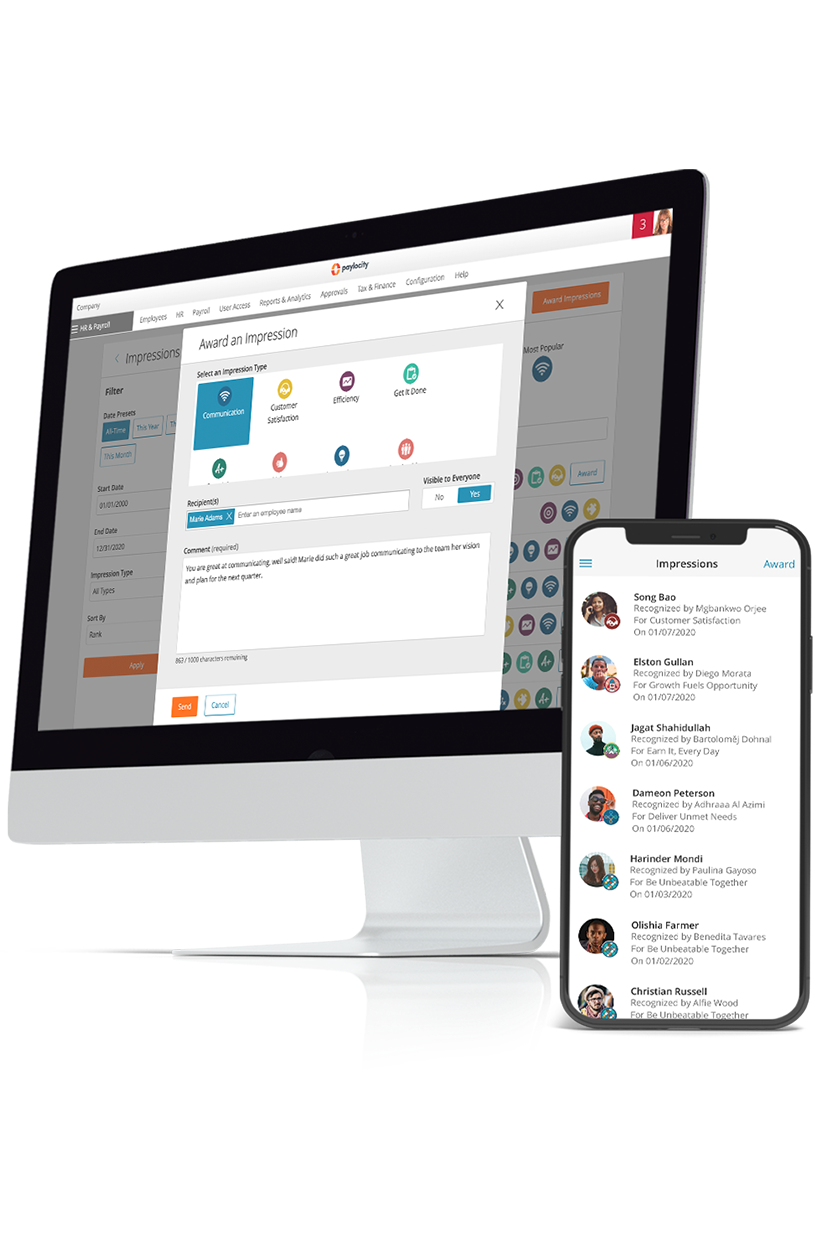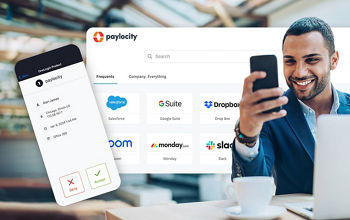resources
The Importance of Employee Engagement in the Workplace
April 13, 2023
Let’s explore employee engagement. Why is it important? What are the benefits? And how can you take engagement to the next level at your organization?
Blog Post

What does employee engagement look like to you?
Is it about how many hours someone works? Maybe it’s about the number and quality of ideas they bring to the table. Well, it can include these things, but its scope goes far beyond them.
In this article, we'll examine what employee engagement is and why it’s so important. We’ll also explore some strategies and top tips for boosting engagement in the workplace.
What Is Employee Engagement?
Employee engagement is how dedicated and passionate your workers feel toward their jobs. An engaged employee cares about your organization’s goals and their part in making it happen.
You might be immediately reminded of that team member who always goes the extra mile to meet a tough deadline. They must be a great example of an engaged employee, right?
Well, it’s actually a little more subtle than that.
Because we’re talking about how people feel and what motivates them, employee engagement can be hard to measure. Working hard and being engaged aren’t the same thing, just as job satisfaction isn’t the same as job fulfillment. When your workforce is engaged, they’re not watching the clock — they’re looking for solutions to help your business succeed.
The foundation of employee engagement is the employee experience. Understanding the differences between the two and how they relate is key to bolstering engagement in your organization.
Employee Experience vs. Employee Engagement
While employee engagement is a measure of the sentiment your workers feel towards their role and your organization, employee experience encompasses every single moment and interaction someone has with an organization while they’re employed.
The experience starts from the second they begin applying for a role with your company. And it only stops when they move on to work somewhere else or retire.
It’s important to understand how the employee experience and employee engagement are intertwined but distinct. For example, if an employee has a poor relationship with their colleagues, they’re unlikely to feel engaged. And if an employee is disengaged, this, in turn, could have a negative impact on their work relationships.
It might seem a bit like a chicken and egg situation. Which came first? Well, as with that classic conundrum, there is actually a definitive answer, even if the framing of the question suggests there isn’t (the egg came first, of course).
That’s because the employee experience begins before any engagement has had a chance to develop. Employee engagement is built upon a solid foundation of positive early experiences in the workplace.
Why Is Employee Engagement Important?
Some managers may not prioritize employee engagement on the grounds that it’s not particularly important, as long as the work gets done.
This is a mistake.
Everything your employees do and say reflects on your organization’s reputation. Engaged employees are a beacon of positivity that speaks well of your business. That kind of enthusiasm is priceless. And it translates into solid business results.
With disengaged employees, it’s a different story. Having no genuine commitment to the vision or project, they have no real reason to care about outcomes. Delivery times start to slip, sloppiness starts to creep in. Your teams become less effective, and it can be a difficult problem to turn around.
So, it’s really better to establish a strong company culture that encourages engagement early on. The benefits of high staff engagement are enormous and wide-ranging.
Read More: Demystifying Employee Engagement for Diverse Worker Populations
What Are the Benefits of Employee Engagement?
Everyone wants to be happy at work. To feel like you’re part of a cohesive and effective team is a very rewarding way to spend your day. But this isn’t just about personal fulfillment, important as that is. Organizations that conduct employee engagement programs see concrete business results.
Increased Productivity
Engaged employees are more productive. According to research by Gallup, the average difference in productivity levels between businesses with the most and least engaged employees is 18%.
It makes sense. Motivation is a key factor in an individual’s productivity. Think about all those occasions when you’ve felt passionate about a project. Most likely, you were happy to put in extra effort to achieve great results.
And if everyone on the team feels valued, the team will work well together and be more productive too. Multiply that effect across the organization as a whole, and it creates a major positive impact.
Reduced Absenteeism
The same Gallup survey also showed an astonishing 81% difference in levels of absenteeism between the most and least engaged business units.
Again, this is fairly intuitive. Disengaged employees are less enthusiastic about their work, so they are less committed to it. It shouldn’t be surprising that engaged employees are absent far less.
Improved Employee Retention
Employee retention can be a major challenge for businesses of all kinds. So, anything that you can do to hold onto your top talent for longer is worth considering.
Because engaged employees feel valued and have an enthusiastic attitude toward their work, they’re more likely to stay. Finding work that’s fulfilling and rewarding is not always easy. Your employees are much less likely to take the risk of jumping ship if they feel positively engaged.
Read More: Best Employee Retention Strategies & Techniques
Enhanced Company Reputation
These days, word-of-mouth — via social media and job review websites — can make or break your employer brand, having a direct impact on your recruitment success. Engaged employees are less likely to post negatively about their employment experience online and may even become vocal advocates for your organization.
In a competitive labor market, that can be a deciding factor in who attracts the best talent. And future employees aren’t the only ones who read your reviews. Potential investors and partners also want to know they are working with a company that’s known for treating its employees fairly.
There really are no downsides to creating a culture that fosters employee engagement. But doing it effectively requires a lot more than providing free lunch on Employee Appreciation Day.
Employee Engagement Strategies That Actually Work
Genuine employee engagement emerges from mutual respect between an organization and its workforce. Any successful strategy to increase engagement has to be implemented with that in mind.
Foster Two-Way Communication
First, there has to be transparent communication going in both directions. Businesses that stick to the old-school model of issuing directives from the top down with no feedback mechanism tend to do poorly with engagement.
Ensure employees are encouraged to share any concerns, questions, or issues they have. Provide options for them to voice their ideas and the tools to do so, like regular surveys and performance journaling.
It’s vital that this isn’t just for show, either. Senior managers should actively seek out feedback from junior colleagues and — just as importantly — act on it.
Celebrate Excellent Work
Everyone wants to know their work is important and valued. Unfortunately, when people get busy, these recognition opportunities often go overlooked.
Introduce a company-wide system of acknowledgment that makes it easy for all employees to recognize one another’s achievements. Not only does peer-to-peer recognition improve morale, it provides consistent feedback that both employees and managers can use to set career development goals.
Even a simple system of perks and digital badges based on demonstrating your company values can have a positive ripple effect throughout the organization, which leads to our next key engagement strategy.
Build a Sense of Community
This is a big one. If everyone in your organization feels as if they are part of a wider community, all pulling in the same direction — that’s a superb sign that employee engagement is high. You can start to achieve this simply by encouraging more positive interactions between employees. Look into shared social events like team lunches, or a digital community to build employee connections.
Of course, many businesses today employ staff who work remotely. If that’s the case, you need to find other ways of fostering a community spirit. Some good virtual employee engagement ideas include promoting virtual water cooler spaces and hosting social events via video chat.
But community goes a lot deeper than planning social activities. A true culture of connection is carefully woven throughout the employee experience, starting with leadership role-modeling.
Engage Leadership in Engagement
It’s vital to place engagement front and center in your talent management philosophy. One of the best ways to encourage broader engagement is by getting leadership involved in a visible way. From walking the plant floor to hosting Q&A sessions online, executives show they are accessible and committed to living your company’s values.
Communication tools that centralize important company announcements also facilitate better transparency about business practices. When leaders actively engage using the same platform all employees use, they democratize information and instill trust.
Read More: Chief Emoji Officer: Leadership and Employee Engagement
Prioritize Employee Development
Don’t forget to take some time to look at the engagement from the employee’s perspective — what will they get out of it? Too often, corporate employee engagement initiatives can come across as insincere, focused only on maximizing productivity with no real concern for the person at the heart of the equation — the worker.
Even if employees love what they do and who they do it for, they may not want to stay in the same job forever. Showing that your company is invested in their future makes them more likely to stay. Workforce development benefits like tuition reimbursement, skills training, and career planning help employees imagine a long and personally meaningful future with you.
Measuring the Impact of Your Engagement Strategies
To realize the benefits of employee engagement, it needs to be intentional and strategic, which means it needs to be measurable. Check out these key performance indicators (KPIs) for employee engagement to start planning with outcomes in mind:
- Discretionary Effort. Discretionary effort is an employee’s willingness to “exceed duty’s call,” according to the Harvard Business Review. That willingness is a strong indicator of engagement but must be balanced with the risk of burnout.
- Inclusion. Engagement is directly related to inclusiveness. Employees who do not feel included are more likely to be disengaged or not engaged at all. Direct employee feedback gathered from a quick survey is the most effective means of gauging how inclusive your organization is.
- Employee Net-Promoter Score (eNPS). Employee net-promoter score is a commonly used employee engagement KPI that indicates how likely an employee is to recommend working at their organization to a family member or friend on a scale of 0-10. Employees who are engaged are more likely to recommend working for the organization.
For more employee engagement metrics, check out our resource “How to Measure Employee Engagement KPIs.”
Enhance Your Employee Engagement in the Workplace
There are plenty of tips for employee engagement success, but actually making them work in practice can be tricky. Measuring employee engagement is one thing; managing it can be time-consuming and expensive if not done efficiently.
The good news is that there are employee engagement tools out there to help you enhance your efforts. Solutions like Paylocity’s employee experience platform offer all-in-one software that you can use to shape your working environment to encourage engagement. The solution you choose should:
- Strengthen connections within and between teams by streamlining communication.
- Simplify the process of keeping everyone updated on news with company-wide announcements
- Enable convenient digital spaces for file sharing, chatting, and cross-team discussions.
- Provide useful HR and Finance integrations to simplify onboarding procedures and integrate new employees into the team
- Streamline support through user-generated Q&A-style “Ask an Expert” discussion boards.
Bringing together a large number of employee-focused functions in one tool cuts down on task duplication and helps operations run more smoothly. And as your employees use the platform, you gain valuable insight into engagement trends as well.
Partner with Paylocity to Level-Up Your Employee Engagement
Engagement in the workplace shouldn’t be an afterthought. And it doesn’t have to be an unsolvable challenge, either. With a little strategy and planning, and the right tools in place, high levels of staff engagement are within reach.
Engaged staff are happier, more productive, more loyal—and much more fun to share a workspace with. We spend much of our lives at work, so employee engagement should be a priority. After all, we’re all on the same team.
Request a software demo to learn more about how Paylocity can help your employee engagement efforts.

Encourage Peer to Peer Praise
Give your employees the power to recognize, connect, and celebrate each other anytime, from anywhere with Recognition & Rewards. When employees give and receive the acknowledge they deserve, positivity becomes infectious. And when that happens, you improve collaboration and engagement and help reduce turnover. Learn more about how you can empower peer feedback today.


